In Part 1 of this series, we learned about the importance of AWS and Pulumi. Now, let’s explore the demo part in this practical session, which will create a service on AWS VPC by using Pulumi.
Before We Start, Ensure You Have the Following
AWS Account with IAM permissions for resource creation
- Install Pulumi CLI:
- # curl -fsSL https://get.pulumi.com | sh
- Install Python & Virtual Environment:
- # python3 -m venv venv
- # source venv/bin/activate # On Windows: venvScriptsactivate
- # pip install pulumi boto3
Configure AWS Credentials
- Check if AWS CLI is Installed
- Run the command:
- # aws –version
- If AWS CLI is not installed, download and install it from AWS CLI installation guide.
Create an IAM User and Assign Permissions
- Go to the AWS Management Console → IAM → Users
- Click Create User, provide a username, and check Access Key – Programmatic Access
- Assign necessary policies/permissions (e.g., AdministratorAccess or a custom policy).
Generate Security Credentials
- After creating the user, download or copy the Access Key ID and Secret Access Key.
Configure AWS CLI with IAM User Credentials
- Run:
- # aws configure
- Enter the credentials when prompted:
- Access Key ID
- Secret Access Key
- Default region (e.g., us-east-1)
- Output format (e.g., json)
Verify Configuration
- Run a test command, such as:
- # aws sts get-caller-identity
- If everything is set up correctly, this will return the IAM user details.
Pulumi Version

AWS Configuration

Pulumi Dashboard
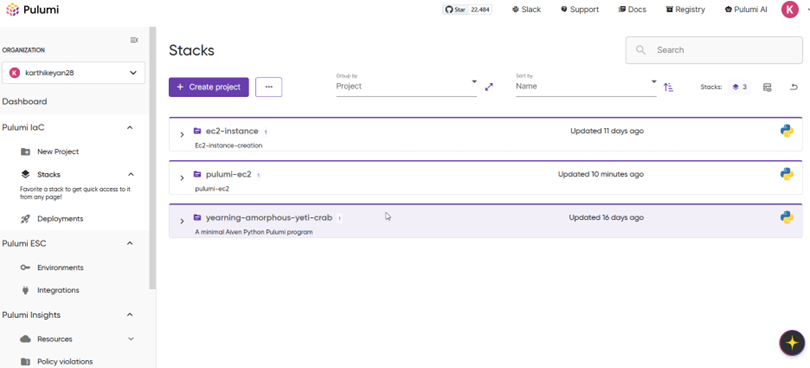
It will be included with the details mentioned above
- Overview
- Readme
- Updates
- Deployments
- Resources
- Settings
Deployment Steps with Commands and Screenshots
Step 1: Initialize a Pulumi Project
- # pulumi new aws-python
Step 2: Define AWS Resources
- Modify __main__.py to create a VPC:
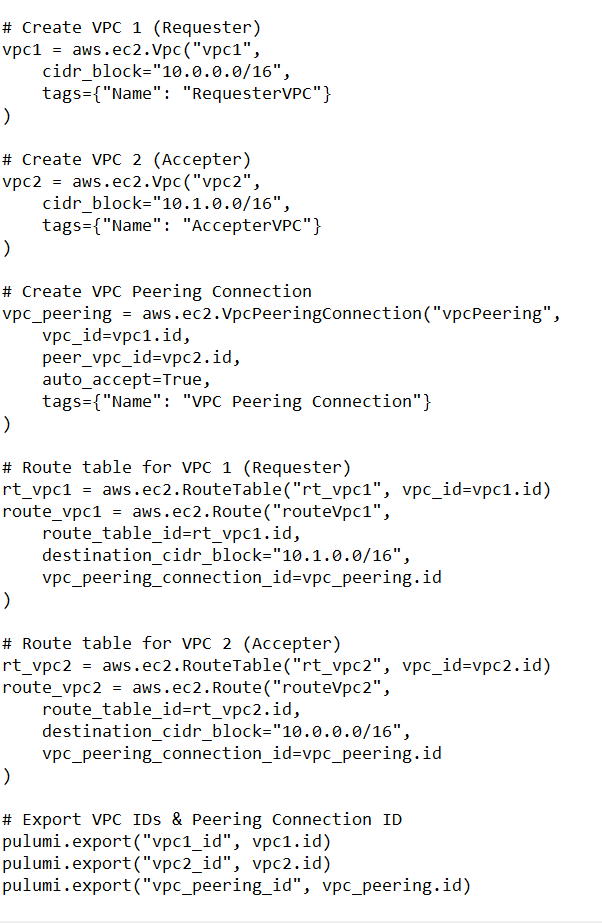
Step 3. Pulumi Preview
- # Pulumi Preview
Pulumi Preview shows a dry-run of changes before applying them. It helps you see what resources will be created (+), updated (~), or deleted (-) without actually making any changes.
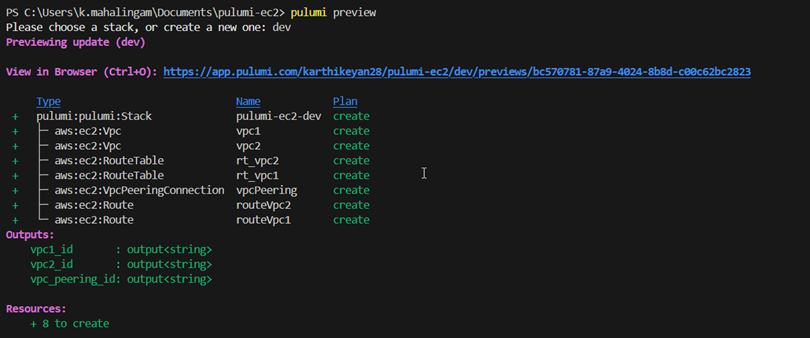
Step 4: Deploy Infrastructure
- # pulumi up
Pulumi up deploys or updates infrastructure by applying changes from your Pulumi code.

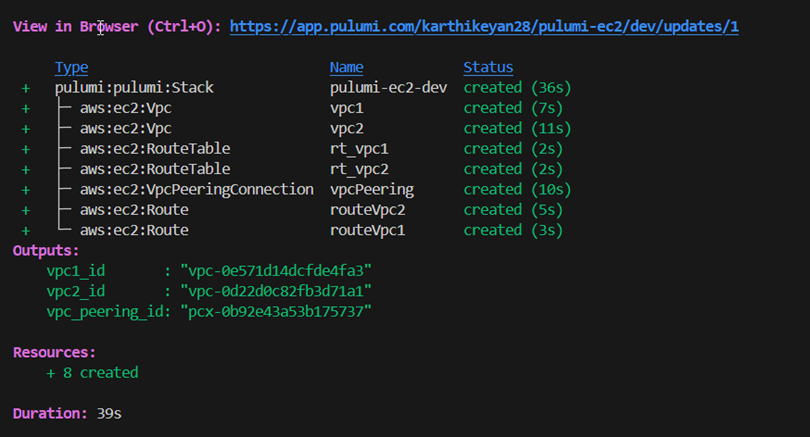
Step 5: Verify Deployment
AWS Console Page
Creating VPC Peering with Pulumi

Pulumi destroy
- # Pulumi Destroy
Removes all resources managed by Pulumi, restoring the environment to its original state. 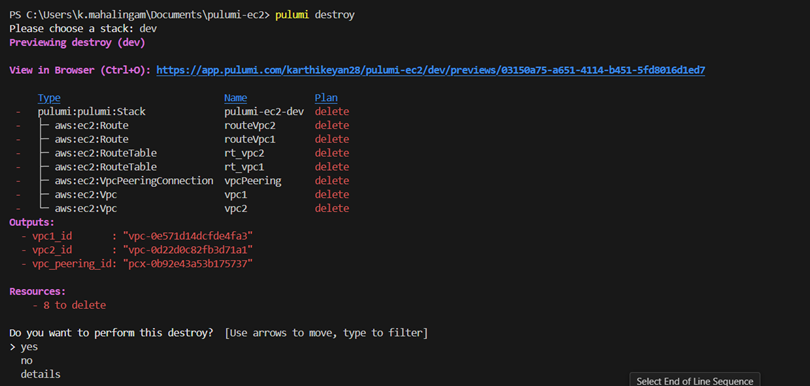
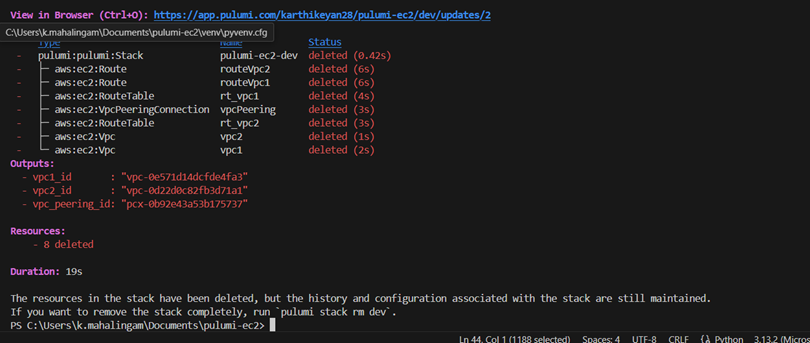
Step 6: Pulumi Stack Remove
- # Pulumi Stack rm <stack name>
Pulumi stack rm removes a Pulumi stack and its state but does not delete cloud resources unless –force is used.


After removed Stack

AWS Console Page after deleting VPC

Conclusion
Pulumi offers a powerful, flexible, and developer-friendly approach to managing AWS infrastructure. By leveraging Pulumi, you can:
- Simplify Infrastructure Management – Define cloud resources as code for consistency and repeatability.
- Enhance Productivity—Create a dynamic infrastructure by using Python’s full capabilities, including loops, functions, and modules.
- Improve Collaboration – Version control your infrastructure with Git and integrate seamlessly with CI/CD pipelines.
- Achieve Multi-Cloud Flexibility – Deploy AWS, Azure, and Google Cloud workloads without changing tools.
- Maintain Security & Compliance – Use IAM policies, automated policies, and state management to enforce best practices.
With Pulumi’s modern IaC approach, you can move beyond traditional Terraform and CloudFormation and embrace a more scalable, flexible, and efficient way to manage AWS resources.
Key Takeaways
- Code-Driven Infrastructure – Use loops, conditionals, and functions for dynamic configurations.
- Multi-Cloud & Hybrid Support – Pulumi works across AWS, Azure, Google Cloud, and Kubernetes.
- State Management & Versioning – Store state remotely with Pulumi Cloud or AWS S3 + DynamoDB.
- Developer-Friendly – No need to learn a new domain-specific language (DSL); use Python!
- Experiment with More AWS Services – Deploy API Gateway, Lambda, or DynamoDB.
- Implement CI/CD with Pulumi – Automate deployments using GitHub Actions, Jenkins, or AWS CodePipeline.
- Explore Pulumi Stacks – Manage multiple environments efficiently.
- Read the Official Pulumi Docs – Pulumi AWS Documentation
References
- Pulumi Official Website: https://www.pulumi.com
- Pulumi AWS Documentation: https://www.pulumi.com/docs/clouds/aws
- Pulumi Python SDK: https://www.pulumi.com/docs/using-pulumi/languages/python
- AWS CLI Configuration: https://docs.aws.amazon.com/cli/latest/userguide/cli-configure-quickstart.html
- AWS IAM Best Practices: https://docs.aws.amazon.com/IAM/latest/UserGuide/best-practices.html
- Pulumi GitHub Repository: https://github.com/pulumi/pulumi
Source: Read MoreÂ



